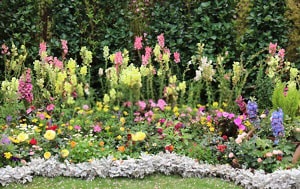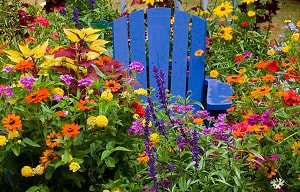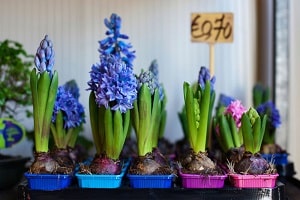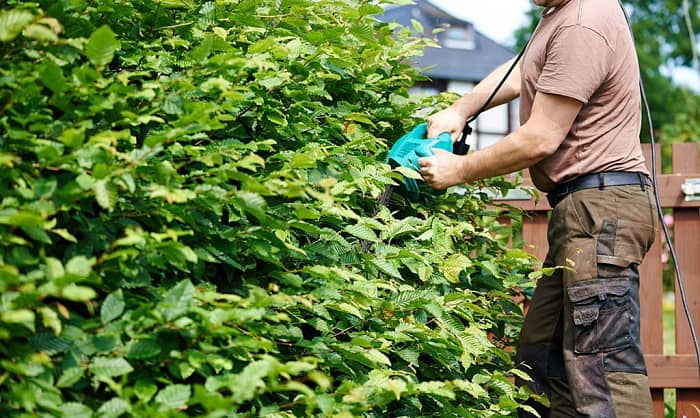Flowers can complement the architecture of a home and make it more beautiful. At the same time, they can attract pollinators that aid the development of your edible crops.
Considering all these benefits, it’s no surprise many gardeners ask themselves, “when is the best time to plant flowers?” Generally, the flower planting schedule begins in spring or fall and revolves around the frost dates. Read below for specifics.
Table of Contents
When Should I Start Planting Flowers?
To know the best time to start a flower garden, you have to look up the spring and fall frost dates for your locality. Then, determine whether the plant you want to grow is a perennial, annual, or bulb. In short:
- Perennials live and bloom for many years.
- Annuals finish their life cycle in one year.
- Bulbs are underground buds with stems and leaves that can produce flowers.
Finally, check out the information below.
1. Planting perennial flowers
- From seeds
If you start perennials from seeds, it’s best to grow them in spring.
In doing so, place the seeds in pots indoors six to ten weeks before the last frost, though note that some flowers can be planted earlier (up to twelve weeks before frosty weather ends).
Once you have your indoor plant, keep track of the transplant time as well.
Depending on the flora, transplanting can take place on the last frost day or one to two weeks after it. That said, some cold-hardy flowers can be moved outside two weeks before ice disappears.
Below are some common perennials and their gardening time:
| Flowers | Indoor seeding (time before last frost) | Outdoor transplant |
| Anise Hyssop
Catmint Columbine Coreopsis Gaillardia Helianthus Hollyhock |
8-10 weeks | On the last frost |
| Asclepias (Milkweed)
Foxglove Heliopsis Phlox |
10-12 weeks | 1-2 weeks after last spring frost |
| Daisy
Delphinium Dianthus |
10-12 weeks | 1-2 weeks before last spring frost |
| Hibiscus | 8-10 weeks | 1-2 weeks after last spring frost |
| Black-eyed Susan
Viola |
8-10 weeks | 1-2 weeks before last spring frost |
| Primrose | 8-10 weeks | 2 weeks before last spring frost |
| Lobelia | 6-8 weeks | Right after last spring frost |
Using the information above, you can determine your gardening schedule.
For example, if you plant Marguerite daisies in Tallahassee, Florida, you can sow seeds indoors on January 8, as this region’s last frost is on March 19. Afterwards, you can transplant the flowers outdoors on March 26.
- Using mature perennials
If you don’t want to spend time preparing pots or sowing seeds, you can get a mature plant from a store instead.
Ideally, you should do this task in autumn, which is also the planting season for perennials grown this way.
Afterwards, put the flower outside in your garden six weeks before the first fall frost.
We’ll use Tallahassee as an example, whose first frost is on November 13. Here, your flower can be planted on October 2.
2. Annual flowers
- Spring planting
Similar to perennials, annual flowers can be seeded indoors before the last frost and transferred outdoors later.
Below are the planting schedules for some annuals. However, if your seed package has different recommendations, adhere to them.
| Plant type | Indoor seeding (time before last frost) | Transplanting | Outdoor seeding |
| Hardy annuals Examples – calendula, larkspur, scabiosa, Shirley poppies | 8-10 weeks | About 4 weeks after indoor seeding | When the soil is workable |
| Half-hardy annuals
Examples – Statice, China aster, chrysanthemums |
6-8 weeks | After the last frost to be safe, as some half-hardy plants will turn brown in icy weather
Some exceptions: Bells of Ireland, snapdragon |
After the last frost |
| Tender annuals
Examples – Marigold, Mexican sunflower, amaranth |
4-6 weeks | After the last frost | After the last frost |
- Fall planting
If you pick fall as your gardening time, know that the seeds won’t sprout but overwinter instead. In other words, this is another way to plant spring flowers or summer flowers.
For example, you can put California Poppy seeds into the ground before the first frost. They will stay there and not develop until the weather facilitates germination.
3. Bulb flowers
There are two seasons for growing bulb flowers: in the spring and the fall.
Bulbs that suit springtime should be in the ground after the last frost and dug up for storage before winter. Some examples of such plants are calla lily, dahlia, freesia, and crocosmia.
Meanwhile, bulbs that thrive in autumn can undergo cultivation a few weeks before the first frost. For example, you can grow daffodils two to four weeks before the first ice date. Other flowers that fall under this category are anemone, iris, tulip, and hyacinth.
Best Time of Day to Plant Flowers
Generally, it’s best to sow seeds when the soil is warm and moist and the weather is not rainy or windy. Moreover, seeding should take place in the morning to provide plants with sunlight.
However, if you’re transplanting flowers, avoid late morning; instead, early in the day is optimal to safeguard the transplants against extreme heat. Another excellent time is late evening when temperatures are lower.
Following the above tips will give your flowers the best chance to acclimatize to the outdoor environment.
What is the Best Time to Plant Bushes?
It’s best to plant bushes in the fall. Doing so will give them enough time to establish their roots and mature in spring. Moreover, you can avoid subjecting the bushes to extreme heat.
Spring is also a good time, though not optimal. If you pick this season, wait until the last frost has passed to start gardening.
Month by Month Flower Planting Guide
Here is a brief list of gardening tasks for each month.
1. January
- Check out and order seeds.
- If you have bulbs or flowers from the previous fall, check the former for decay and water the latter.
2. February-March-April-May-June
- Start seeds for transplanting. For example, you can grow annuals that suit cool weather.
- Add mulch or compost to the soil to improve its quality and control weeds.
- Check the plants for disease and pests.
- Deadhead flowers if necessary.
- In addition to the new flowers, take care of the plants you already have.
- Keep a journal to remember your planting dates and note down your gardening tasks.
3. July
- Fertilize your annuals and remove their faded flowers.
- Pinch or prune plants to encourage branching.
4. August
- Water flowers well to protect them against summer heat.
- Deadhead annuals for more blooms.
- If you want to garden in the fall, order seeds/bulbs.
5. September-October
- Check the soil and amend it if necessary.
- Plant autumn bulbs and remove seed heads from perennials.
- Dispose of dead annual plants.
6. November
- Mulch flowers that can handle cold weather.
- Dig up springtime bulbs that cannot tolerate winter and store them.
7. December
- Continue to plant and mulch flowers. Stop when the first frost arrives.
- Note down problems in your garden that you can work on before the next season.
Conclusion
By now, it should be obvious when is the best time to plant flowers. As long as you follow seed package instructions and protect plants from extreme weather, you can brighten up your home with blossoms of various colors.
What’s more, it’s possible to enjoy fresher air and exercise your muscles through growing flowers. Start your garden today!

Hi, I am William – Floridayards’ digital content creator. My job is to find answers to all your concerns with thorough research and our team’s expert advice. I will also bring you honest reviews on the best products and equipment for raising your beautiful garden. Please look forward to our work!















